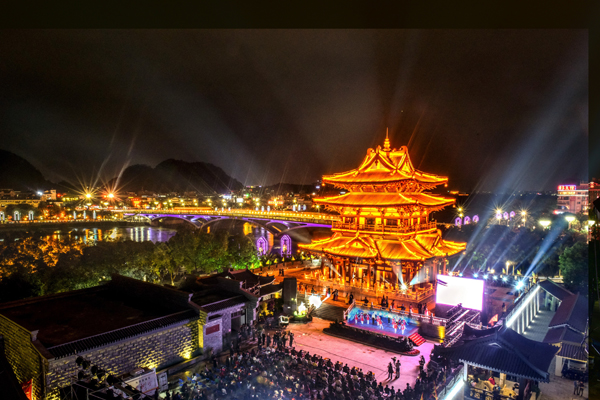Scenic Guilin draws on rich culture, history to enhance visitor experience
Guilin, in South China's Guangxi Zhuang autonomous region, has made great strides in utilizing its historical and cultural resources under a program initiated by the local government in 2014.
Two years ago, renovation work on the Xiaoyao Building, a three-story wooden structure that dates back to the Tang Dynasty (618-907), was completed.
The building had been destroyed in 1944 during the War of Resistance Against Japanese Aggression (1931-45).
Guilin has been renowned for its picturesque karst landscape for centuries and remains a popular destination, receiving an average of 80 million inbound tourist trips per year.
"Guilin is like a thick book. The mountains and waters only form her cover. The landscape may change, but the culture will survive and flourish," said Zhao Leqin, Party chief of Guilin.
In addition to the Xiaoyao Building, renovation work has focused on 28 former residences of notable people who lived in Guilin and Zhengyangdong Lane - a mixed commercial and residential area that dates back to the Ming Dynasty (1368-1644).
Fan Xinhong, vice-mayor of Guilin, said that the city's tourism industry will develop and upgrade by focusing on traditional culture and meeting the needs of visitors.
Residents are capitalizing on this burgeoning industry by opening eateries, selling produce such as monk fruits and operating homestays.
In Yangshuo county, to the south of Guilin, a vocational school for homestay employees and managers opened on Oct 11.
The school, which is the first of its kind in the region, aims to give local farmers the skills they need to work in the service industry.
There are more than 20,000 homestay beds and about 300,000 permanent residents in Yangshuo.
Zhao, Party chief of Guilin, said that in the future the local tourism industry will rely more on providing unique cultural experiences and services than attracting large numbers of visitors.
"Guilin boasts rich cultural resources in terms of arts, ethnic groups and performances, and a long history during which the city has seen prosperity and wars," he said.
In 1999, the government of Guilin invited a team of experts to identify sites of historical interest within the city, which were then protected during subsequent urban renewal projects. This helped to lay a solid foundation for preserving the tourism resources the city has today.
In its tourism development plan (2015-20), the Guilin government vowed to play up the city's role as a cradle of southern Chinese culture, as well as its links to the Qin, Song and Ming dynasties.
Other highlights to be promoted include Guilin's many celebrity residents since the late Qing Dynasty (1644-1911) and the role it played in the War of Resistance Against Japanese Aggression.
The local government has further called for new tourism products to be developed that bring together the area's history and culture, facilitating the formation of tourist clusters.
Lu Jun, a tourism researcher at the Guilin-based Guangxi Normal University, said developing popular cultural tourism products and services was key.
"The government, enterprises, scholars and citizens should all be involved in the development of these products and services, as they are all a part of Guilin, and thus must be engaged in the upgrading of its tourism industry," Lu said.
Gu Yunling, a tourism development researcher at the Party School of the Communist Party of China's Guilin Municipal Committee, said the city's unique selling point should be its rich historical and cultural resources that seamlessly converge with the natural landscape.
Guilin Tourism University, an affiliate of the United Nations World Tourism Organization, has sent more than 1,000 students to the United States, United Arab Emirates, Canada, Japan and France for internships or employment.
The university has established long-term cooperative relations with more than 100 tourism enterprises, both at home and abroad.
In the first half of this year, there were about 48 million tourist trips to Guilin, up 18.69 percent year-on-year. This generated 60.42 billion yuan ($8.7 billion) in tourism revenue, a 33.08 percent year-on-year increase, according to the Guilin government.
Lin Na, Party chief of Guilin Tourism University, said development of the city's tourism industry was being restricted by a lack of high-end talent, despite robust consumption and investment.
"That's why our graduates are popular among our partner enterprises, and we are obliged to adjust the curriculum to better serve Guilin's needs in the process of upgrading its tourism industry," Lin said.

A climber scales a cliff in Yangshuo county, one of Guilin's major scenic spots. Provided to China Daily

Night view of the Xiaoyao Building, a three-story wooden structure that dates back to the Tang Dynasty (618-907) in Guilin. Wang Zhanfei / For China Daily










